Eye vs. Camera
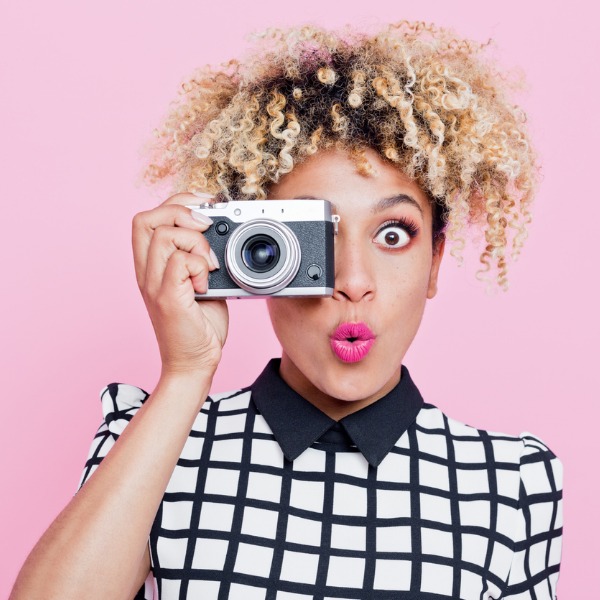
Woman with camera (izusek, iStockphoto)

Woman with camera (izusek, iStockphoto)
How does this align with my curriculum?
| Grade | Course | Topic |
|---|
The human eye lets us see the world by sending impulses to our nervous system. In many ways, it is very similar to other optical devices, including cameras.
Your eyes and your brain work together to allow you to see. In fact, human eyes and brains have been coevolving for millions of years.
Your eyes are a bit like something else that captures images of the world: a camera. Let’s look at the similarities and differences between an eye and a camera.
How are an eye and a camera similar?
An eye and a camera both have lenses and light-sensitive surfaces.
Your iris controls how much light enters your eye. Your lens helps focus the light. The retina is a light-sensitive surface at the back of your eye. It captures an image of what you’re looking at. Then, the retina sends impulses to your brain along the optic nerve. Finally, the brain interprets what you’re seeing.
Did you know?
The most common eye colour in the world is brown.
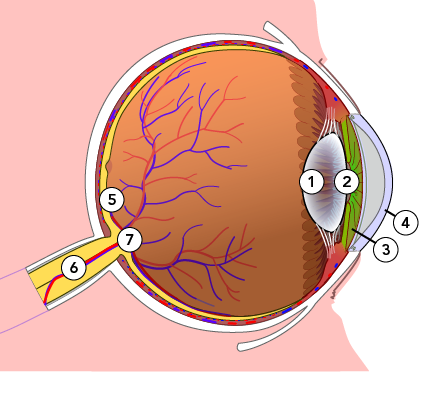
Illustration - Labels
A human eye has a lens (1), pupil (2), iris (3), cornea (4), retina (5), optic nerve (6), and blind spot (7).
This is similar to what happens when a camera captures an image. First, light hits the surface of the camera’s lens. The aperture controls how much light enters the camera. Then, the light makes its way to a light-sensitive surface. For a long time, this surface was the camera’s film. In today’s digital cameras, this surface is an imaging sensor chip.
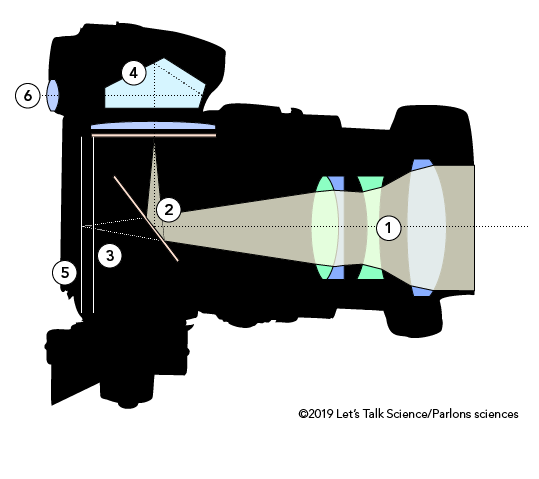
Illustration - Labels
An SLR camera has a lens (1), mirror (2), aperture (4), prism (4), film or imaging sensor (5) and eyepiece (6).
Retinas, film, and imaging sensor chips all have one other thing in common. They all receive an inverted (upside-down) version of the image. Why? The lens in both an eye and a camera is convex, or curved outwards. When light hits a convex object, it refracts. This flips the image upside-down.
But you don’t see images upside-down. And the movies you watch aren’t upside-down either. Why not?
This is because your brain steps in to help your eyes. It knows the world is supposed to be right side up. So it flips the image over again. Digital cameras are programmed to make the correction on their own. Non-digital cameras contain a prism or mirror that flips the image so it appears right side up. Film is transparent so you can view the images on it the right way around.
How are an eye and a camera different?
There are two major differences between the human eye and a camera. The first relates to how they focus an image. The second relates to how they process colour.
How does an eye focus differently than a camera?
The lenses in your eyes change shape to stay focused on a moving object. The thickness of the lens also changes to accommodate the image being viewed. It is able to do this because the lens is attached to small muscles that contract and relax.
A camera lens can’t do this. That’s why photographers change lenses, depending on how far away they are from an object. Mechanical parts in the camera lens also adjust to stay focused on a moving object.
How does an eye process colour differently from a camera?
Your retinas contain two types of photoreceptors: rods and cones. Rods allow you to see in low light. They aren’t useful for colour vision.
Cones let you see in colour. There are three types of cones. Each type responds to different wavelengths of light. Red cones respond to long wavelengths. Blue cones respond to short wavelengths. Green cones respond to medium wavelengths.
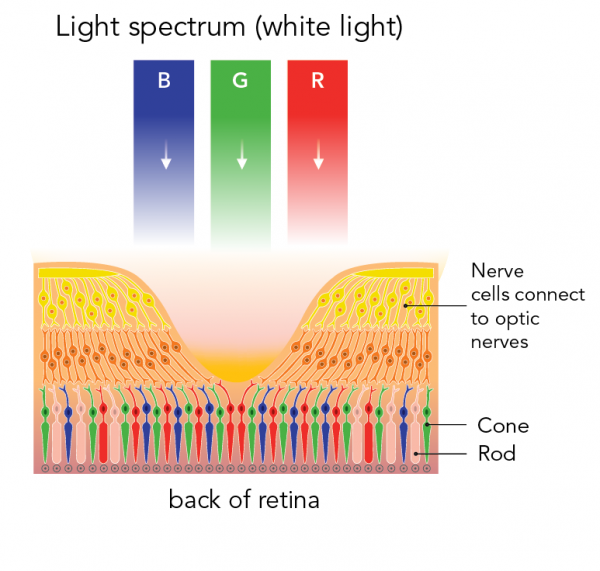
When your brain activates different combinations of cones, you can see the world in colour.
Did you know?
Colour vision deficiency is often called colour blindness. Colour blindness affects people whose retinal cones don’t work properly.
Cameras also have photoreceptors. But they only have one type. Cameras respond to red, blue and green light using filters placed on top of their photoreceptors. The photoreceptors in a camera are evenly distributed across the lens. In the human eye, however, the cones are concentrated at the centre of the retina. There are no rods at all at the centre of the retina.
How else are your eyes different from a camera?
Because a camera has photoreceptors all over its lens, it always sees a “full” picture. Your eyes, on the other hand, have a blind spot. That’s the point where the optic nerve connects to the retina. It has no photoreceptors at all.
Most of the time, you don’t notice your blind spot. This is because when light hits this area of one eye, your brain uses information from your other eye to fill in the gap.
If you want to test your blind spot, you can with a simple experiment.
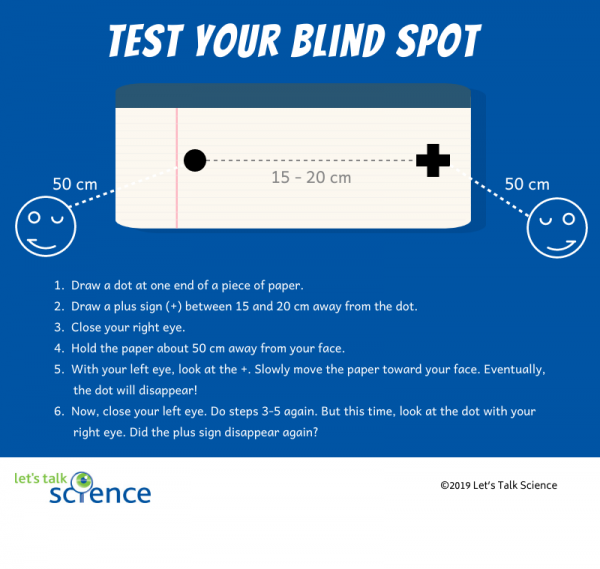
Infographic – Text Version
1. Draw a dot at one end of a piece of paper.
2. Draw a plus sign (+) between 15 and 20 cm away from the dot.
3. Close your right eye.
4. Hold the paper about 50 cm away from your face.
5. With your left eye, look at the +. Slowly move the paper toward your face. Eventually, the dot will disappear!
6. Now, close your left eye. Do steps 3-5 again. But this time, look at the dot with your right eye. Did the plus sign disappear again?
Finally, your eyes actually stop seeing clearly whenever you spin or turn quickly. It’s why dancers learn the technique of spotting. They focus on one spot and turn their head quickly to refocus on that spot with each turn. This helps maintain their balance and orientation. It can also keep them from getting dizzy. Now a camera can’t do that!
Starting Points
- Have you ever heard the old saying, “Don’t believe anything you hear and only half of what you see”? What does this mean to you?
- Have you ever experienced the “blind spot” in your vision?
- Do you like to take photos and videos? Why or why not?
- In the future, do you think it will be possible to replace or repair damaged eyes with man-made parts like those used in cameras? Why/why not?
- Can we really believe what we think we see knowing that our brain will “fill in” missing information? Explain.
- What new technologies are helping people with vision problems see better?
- What does it mean when we say that “we see with our brains and not our eyes”? Explain.
- What things can you do when you are taking a photo to make it as clear as possible? What things does your camera do for you (automatically) to make a clear image?
- In what ways is camera technology becoming more like a human eye?
- How does our scientific understanding of how the brain is involved in vision help explain why two people can see the same event but remember different things about it?
- Do you think cameras hold more potential for technological advancement compared to the human eye? Explain.
- Do you think that camera technology will eventually be used to improve the human eye? Why/why not?
- This article can be used to support teaching and learning of Biology, Anatomy, Technology & Engineering, Physics; Waves, Sound, Light related to the human eye, vision, optical devices, visible light and nervous system. Concepts introduced include iris, lens, retina, optic nerve, aperture, film, imaging sensor chip, inverted, convex, refracts, accommodate, photoreceptors, rods, cones, wavelength and blind spot.
- Before reading the article, teachers could have the students complete an Anticipation Guide to get them thinking about this topic. Students could concentrate on thinking about the advantages/disadvantages of eyes vs. cameras to see/observe the world. This will help them activate prior knowledge and begin to think inquisitively about this topic. Download ready-to-use reproducibles using the Anticipation Guide learning strategy for this video in [Google doc] and [PDF], and the Answer Key in [PDF] format.
- To help consolidate learning from the article, teachers could have students create a graphic organizer, such as a T-chart, to summarize the similarities and differences between eyes and cameras.
- For a hands-on follow-up, teachers could have students try the blind spot test outlined in the article. Students could also try out a colour blindness test and/or look at different visual illusions and compare their perceptions to others in the class.
- To extend learning after reading the article, teachers could lead a discussion about the potential for technology to replace humans or to improve the human body (e.g., see more accurately). In small groups, have students use a Pros & Cons Organizer to help identify limitations of each. Download ready-to-use reproducibles using the Pros & Cons Organizer learning strategy for this video in [Google doc] and [PDF]
- As an extension learning activity, teachers could have students conduct research on recent innovations in camera technology. This research could be shared with the class. Students could follow up their research with a discussion about ways that more advanced cameras could be used in the future.
Connecting and Relating
- Have you ever heard the old saying, “Don’t believe anything you hear and only half of what you see”? What does this mean to you?
- Have you ever experienced the “blind spot” in your vision?
- Do you like to take photos and videos? Why or why not?
Relating Science and Technology to Society and the Environment
- In the future, do you think it will be possible to replace or repair damaged eyes with man-made parts like those used in cameras? Why/why not?
- Can we really believe what we think we see knowing that our brain will “fill in” missing information? Explain.
- What new technologies are helping people with vision problems see better?
Exploring Concepts
- What does it mean when we say that “we see with our brains and not our eyes”? Explain.
- What things can you do when you are taking a photo to make it as clear as possible? What things does your camera do for you (automatically) to make a clear image?
- In what ways is camera technology becoming more like a human eye?
- How does our scientific understanding of how the brain is involved in vision help explain why two people can see the same event but remember different things about it?
Nature of Science/Nature of Technology
- Do you think cameras hold more potential for technological advancement compared to the human eye? Explain.
- Do you think that camera technology will eventually be used to improve the human eye? Why/why not?
Teaching Suggestions
- This article can be used to support teaching and learning of Biology, Anatomy, Technology & Engineering, Physics; Waves, Sound, Light related to the human eye, vision, optical devices, visible light and nervous system. Concepts introduced include iris, lens, retina, optic nerve, aperture, film, imaging sensor chip, inverted, convex, refracts, accommodate, photoreceptors, rods, cones, wavelength and blind spot.
- Before reading the article, teachers could have the students complete an Anticipation Guide to get them thinking about this topic. Students could concentrate on thinking about the advantages/disadvantages of eyes vs. cameras to see/observe the world. This will help them activate prior knowledge and begin to think inquisitively about this topic. Download ready-to-use reproducibles using the Anticipation Guide learning strategy for this video in [Google doc] and [PDF], and the Answer Key in [PDF] format.
- To help consolidate learning from the article, teachers could have students create a graphic organizer, such as a T-chart, to summarize the similarities and differences between eyes and cameras.
- For a hands-on follow-up, teachers could have students try the blind spot test outlined in the article. Students could also try out a colour blindness test and/or look at different visual illusions and compare their perceptions to others in the class.
- To extend learning after reading the article, teachers could lead a discussion about the potential for technology to replace humans or to improve the human body (e.g., see more accurately). In small groups, have students use a Pros & Cons Organizer to help identify limitations of each. Download ready-to-use reproducibles using the Pros & Cons Organizer learning strategy for this video in [Google doc] and [PDF]
- As an extension learning activity, teachers could have students conduct research on recent innovations in camera technology. This research could be shared with the class. Students could follow up their research with a discussion about ways that more advanced cameras could be used in the future.
Learn more
Eye vs. Camera (2015)
A TED-Ed video (4:56 min.) by Michael Mauser which outlines the similarities and differences between your eye and a video camera.
An article for How Stuff Works by Tom Harris explaining how a camera processes an image, includes diagrams.
References
Ferland, M. Comparison of the human eye to a camera (2018, April 10). Sciencing.
Kamps, H. J. What’s the difference between a camera and a human eye? (2017, November 24). Medium.
Mental Floss UK. How our eyes see everything upside sown (2017, February 10). Mental Floss.
National Keratoconus Foundation. (n.d.). How does the human eye work?
Neel, J. (2014, October 16). The upside down world inside your camera Lens Garden.